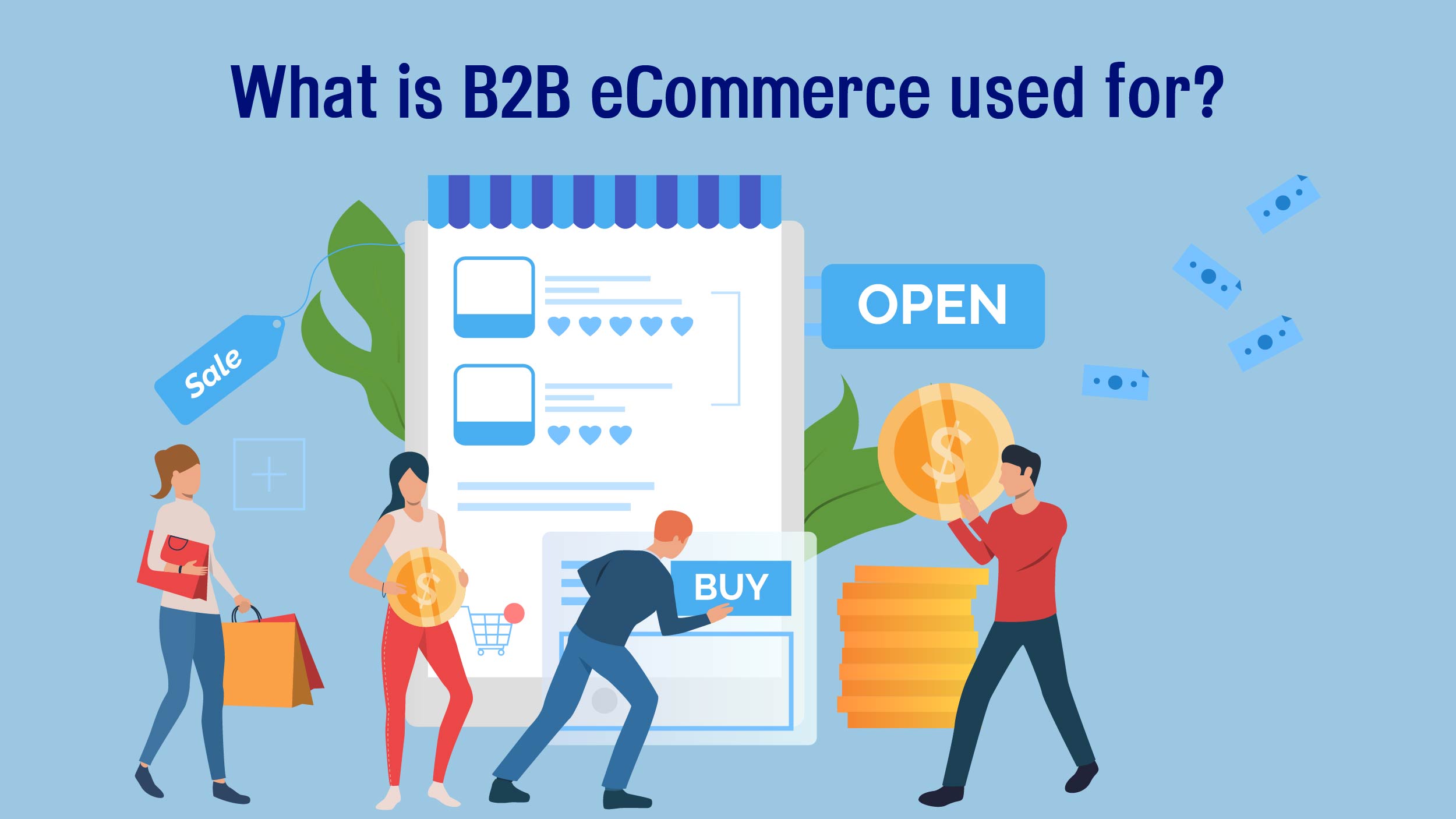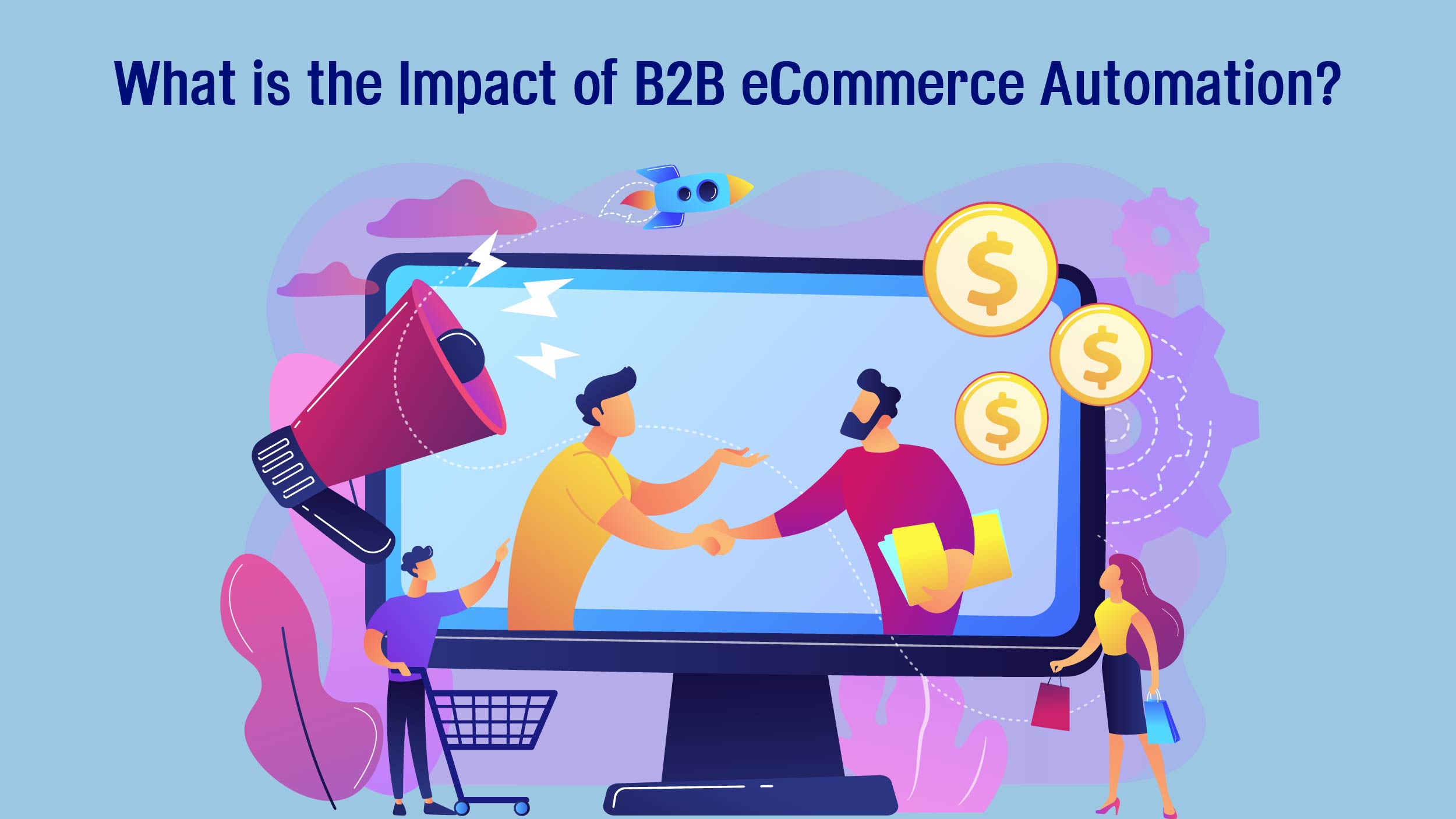There are approximately 3 million B2B businesses in the United States alone. This means companies have to find ways to streamline transactions and conduct efficient operations.
However, this requires a sophisticated yet simple solution- B2B eCommerce. At $20.4 trillion in 2022, the worldwide B2B eCommerce market is expected to be valued five times larger than the B2C market.
Before the pandemic, just 13% of all B2B product sales in the United States took place on eCommerce websites, demonstrating how slowly B2B companies have historically embraced eCommerce. But, this scenario has changed dramatically and we will explore how in this article.
What is B2B eCommerce?
Business-to-business e-commerce, or B2B e-commerce, is the term used to describe the online sales of products and services between companies. It is the digital interchange of goods, services, or data between two or more businesses as opposed to a company and a single customer.
What is B2B eCommerce used for?
 Online business-to-business transactions are made easier through B2B e-commerce. Digital orders and transactions help distributors, manufacturers, wholesalers, and other B2B sellers increase the efficacy and efficiency of their purchasing. B2B eCommerce aims to help businesses reach a wider consumer base, reduce expenses, and simplify the procurement process.
Online business-to-business transactions are made easier through B2B e-commerce. Digital orders and transactions help distributors, manufacturers, wholesalers, and other B2B sellers increase the efficacy and efficiency of their purchasing. B2B eCommerce aims to help businesses reach a wider consumer base, reduce expenses, and simplify the procurement process.
As to Forbes, there has been a 250% surge in mobile B2B orders over the last three years. By 2025, it’s predicted that B2B e-commerce in the US will surpass $710 billion in sales through mobile devices. Mobile drives a significant portion of sales that could be lost otherwise.
4 Key Considerations for Effective B2B eCommerce Website Development
In today’s business landscape, B2B eCommerce is experiencing significant growth. Businesses seeking to participate in this trend require a well-designed and user-centric website to facilitate seamless online transactions.
Fortunately, a range of resources and strategies are available to guide the development process.
Here are some key considerations for establishing a successful B2B eCommerce website:
- User Interface (UI) and User Experience (UX): Streamlined UI/UX design plays a critical role. A user-friendly interface coupled with an intuitive user experience fosters a positive browsing experience, ultimately leading customers toward conversion. Many platforms offer B2B-specific themes that streamline design and simplify back-end operations, providing a valuable starting point for website development.
- Understanding Your Target Market: To ensure website development efforts are productive, it’s essential to have a clear understanding of the needs and preferences of your target B2B audience. This could include wholesalers, corporate buyers, or other business entities. Aligning your website’s offerings with these specific needs allows for a more targeted and effective approach.
- Responsive Design: A well-designed website with all the necessary features can become an obstacle if it fails to adapt across different devices. Responsiveness ensures your website looks and functions seamlessly on desktops, tablets, and smartphones, preventing customer frustration.
- B2B Transaction Specificity: B2B transactions often have unique requirements compared to traditional consumer e-commerce. This might include features such as tiered pricing structures for different customer segments, support for specific payment options (e.g., net terms), or integration with existing enterprise resource planning (ERP) systems. Customization and functionality should be prioritized to meet these distinct B2B needs.
By acknowledging these key considerations, businesses can embark on the B2B eCommerce website development process with a solid foundation.
Also Read: B2B Customer Experience: Everything You Need to Know in 2024
What is the Impact of B2B eCommerce Automation?

- Effortless Order Processing: Bid farewell to manual data entry hassles! Automation seamlessly manages order reception, processing, and delivery, minimizing errors and conserving valuable time.
- Targeted Marketing Campaigns: Tailor your marketing endeavors to perfection. B2B automation enables personalized messaging based on customer behavior, nurturing leads automatically and leading to enhanced conversions.
- Boost Productivity: Liberate your team from repetitive tasks! Automate inventory management, order tracking, and customer support, empowering your workforce to focus on strategic initiatives.
- Personalized Approach: Embrace automation without sacrificing personalization. Utilize customer data to tailor offerings and communication, fostering a more engaging buyer experience.
- Seamless Integration: Forge connections between your B2B eCommerce platform and existing ERP systems effortlessly. This ensures streamlined data flow, bolstering inventory management and overall business efficiency.
- Optimize Your Sales Funnel: Guide leads through the buyer’s journey with precision. Leverage automation for targeted messages leads scoring, and workflows, ultimately elevating conversion rates and revenue.
- Seamless Customer Service: Provide your customers with a seamless experience. Automated product recommendations and responsive support contribute to customer satisfaction and loyalty. According to G2 and TrustRadius, 84% and 55%, respectively, of B2B purchasers utilize review sites when making buying decisions.
- Data-Driven Decisions: Utilize B2B automation tools to extract insights. Learn important information about sales trends, consumer behavior, and performance indicators to help you make smart decisions and promote future expansion.
B2B eCommerce automation is about giving your company the tools it needs to succeed in the digital sphere, not simply about technology.
Benefits of B2B eCommerce Platform
You may need to give your B2B operations a modern makeover if they are still dependent on outdated techniques like cold calling and faxing.
Making the switch to e-commerce requires choosing the appropriate B2B platform, which is essential for keeping up with changing client needs and updating outdated infrastructure. Today’s organizations may use cutting-edge technologies to improve client experiences and streamline operations in a sea of options.
Here’s why integrating a B2B eCommerce platform could revolutionize your business:
Enhanced Supplier and Customer Management
Centralizing operations within an eCommerce platform simplifies tasks, from customer data management to order processing and inventory control. Automated sales processes facilitate seamless interactions among businesses, suppliers, and distributors, optimizing B2B operations and elevating customer satisfaction.
Maximized Sales Opportunities
Accessible eCommerce platforms provide avenues for cross-selling and up-selling to existing clientele. Personalization emerges as a key strategy in retaining customer interest, with 55% of B2B marketing budgets dedicated to enhancing digital experiences.
While B2C personalization often involves features like augmented reality fitting rooms, B2B counterparts include tailored quotes, discounts, and shipping rates, alongside AR tours, personalized sales portals, and mobile ordering facilities.
Expansion Potential
B2B eCommerce not only caters to current clientele but also facilitates market expansion and customer acquisition. With a plethora of digital solutions and eCommerce platforms, businesses can transcend geographical boundaries and explore new market segments with ease.
Robust Data Analytics
eCommerce platforms enable comprehensive tracking of customer behavior, facilitating data-driven decision-making. Numerous tools are available in the market to help businesses identify operational strengths and areas for improvement, optimize user experiences, and drive business growth.
As cloud computing, storage, and predictive analytics become imperative for B2B digitization, leveraging data analytics emerges as a cornerstone for enhancing the shopping journey.
Embracing innovative technologies and harnessing data analytics is no longer optional for B2B businesses embarking on digital transformation. By integrating a B2B eCommerce platform, businesses can unlock operational efficiencies, enhance customer experiences, and drive sustained growth in the digital era.
Differences between B2B and B2C
Business-to-business (B2B) and business-to-consumer (B2C) are two different business concepts that differ significantly. Businesses sell products or services to other businesses in the B2B market, whereas direct sales to individual customers occur in the B2C market. B2B transactions are characterized by personalized solutions and continuous support, along with longer-term connections; in contrast, B2C transactions are frequently quick and focused on the needs of specific customers.
Building relationships and providing thorough product information are top priorities in B2B marketing, whereas emotional appeals and brand awareness are more common in B2C marketing. In contrast to B2C transactions, which typically involve smaller orders, fixed prices, and more straightforward distribution routes, B2B transactions typically entail greater order volumes, negotiated pricing, and complex distribution networks.
While B2C customer service prioritizes timely and effective support for individual consumers, B2B customer care frequently provides technical assistance and dedicated account managers. Businesses must understand these differences to customize their strategies and successfully serve their target market.
Final Words
Studies predict that transactions on B2B eCommerce will reach $1.8 trillion by 2023, making up 17% of all B2B sales in the US. This makes B2B e-commerce a substantial sales channel in digital commerce. Following the epidemic, 73% of millennials have become involved in the process of purchasing, which is driving this trend. Accessible and affordable selling options are provided via B2B platforms such as mobile ordering, AR tours, tailored sales portals, and self-service features. This trend enables merchants to scale up relationship personalization, empower self-serving customers, and reach a large audience with fewer resources. Not only is B2B eCommerce on the rise, but it also improves efficiency and streamlines processes.


Comments are closed.